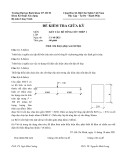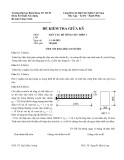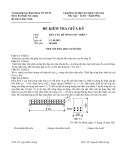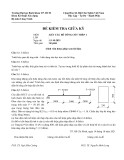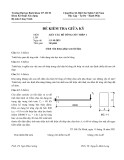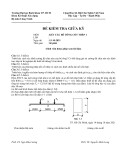
98 Thanh Ngoc Phan, Akira Hosoda, Hamed Salem, Mikihisa Yamada
NUMERICAL SIMULATION ON THE SEISMIC PERFORMANCE OF
PC UTILITY POLES ON SHINKANSEN VIADUCT USING AEM AND FEM
Thanh Ngoc Phan1,2*, Akira Hosoda3, Hamed Salem4, Mikihisa Yamada5
1The University of Danang - University of Technology and Education, Vietnam
2Institute for Multidisciplinary Sciences, Yokohama National University, Japan
3Institute of Urban Innovation, Yokohama National University, Japan
4Structural Engineering Department, Cairo University, Egypt
5Graduate School of Urban Innovation, Yokohama National University, Japan
*Corresponding author: ptngoc@ute.udn.vn
(Received: September 26, 2024; Revised: October 11, 2024; Accepted: October 12, 2024)
DOI: 10.31130/ud-jst.2024.529E
Abstract - The 2011 Tohoku earthquake caused severe damage
to various infrastructures in the Tohoku region of Japan.
Particularly, prestressed concrete (PC) utility poles on
Shinkansen viaducts sustained significant damage, leading to
prolonged service disruptions. To better understand the structural
behavior and failure mechanisms of these poles, JR East company
initiated a series of experimental investigations to examine their
bending capacity and failure modes under cyclic loading. This
research aims to numerically simulate the performance of the
tested PC utility poles using Applied Element Method (AEM) and
Finite Element Method (FEM). The simulation results
demonstrate that both AEM and FEM effectively reproduce the
load-displacement relationship observed in the test. Additionally,
this study discusses the material models employed in simulations,
considering the limitations inherent in numerical modeling. The
findings provide critical insights into the structural performance
of the poles under seismic loading and offer useful numerical
tools for the development of retrofitting strategies.
Key words - Applied Element Method; Finite Element Method;
prestressed concrete utility poles; seismic resistance
1. Introduction
The 2011 Great East Japan earthquake characterized by
its high magnitude and long duration, caused severe damage
to various infrastructures, including railway systems in the
Tohoku region of Japan [1]. In particular, prestressed
concrete (PC) utility poles on Shinkansen viaducts sustained
significant damage, leading to prolonged service
disruptions, as shown in Figure 1 [2]. According to a
technical report, the failure of PC poles was categorized into
two main groups including breakage damage near the
footing due to crushing and spalling of concrete (Figure 2a)
and inclination of the poles (Figure 2b) [2].
After the event of Tohoku earthquake in 2011, the
seismic design code for railway structures was revised in
2012 and followed by seismic design guidelines in 2013 [3].
As for the existing PC utility poles, several conventional
retrofitting methods were proposed and practically applied
[1, 2, 4]. However, due to the large time consumption for the
construction of these methods while the retrofitting plan for
about 8,000 poles was fixed by the East Japan Railway
Company (JR East) from 2023 to 2033, there is a need to
develop a new method which can be easily installed within
a short period of time. Therefore, to better understand the
structural behavior and failure mechanisms of these PC
utility poles, JR East initiated a series of experimental
investigations to examine their bending capacity and failure
modes under cyclic loading [4].
Figure 1. Damage of PC utility poles on Shinkansen viaduct [2]
a) Example of breakage b) Example of inclination
Figure 2. Examples of damage types [2]
Due to the limited numerical analysis studies in this
field, the current research aims to numerically simulate the
performance of the tested PC utility poles using the
Applied Element Method (AEM) and Finite Element
Method (FEM). Within the scope of the study, the material
models employed in the simulations, considering the
limitations inherent in numerical modeling are discussed.
The findings provide critical insights into the structural
performance of PC utility poles under seismic loading and
offer useful numerical tools for the development of
retrofitting strategies in the near future.
2. Experimental program for seismic performance of
PC utility poles
In this research, the experiment done by JR East using
a cyclic loading system to investigate the seismic
performance of PC utility poles was utilized for the
simulation verifications [4]. The characteristics of the
tested specimen, including the designed cracking bending









